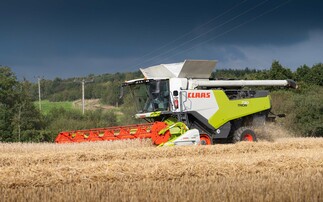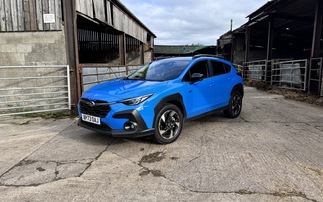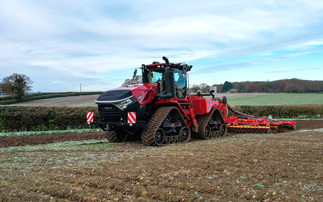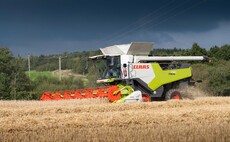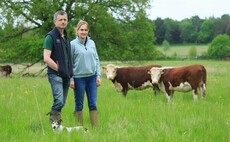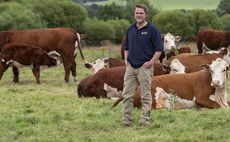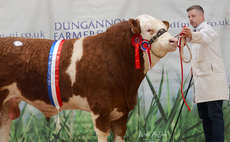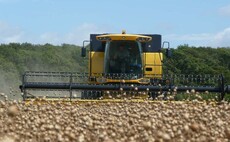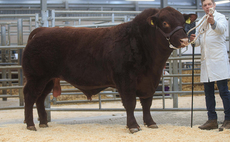
Building on what the TM320 achieved, JCB has launched new model of pivot steer telescopic handler, the TM420.
James Rickard finds out more with a test drive...
Persistent rain, thick mud and slippery slopes provided exceptionally challenging conditions to try out JCB's new TM420 pivot steer telescopic handler.
Highlighting the machine's major updates, the Battle of the Somme-like conditions delivered the perfect proving ground.
Featuring a larger wheelbase, longer overall length, bigger tyre options and a completely redesigned boom and chassis, the TM420 is the latest addition to JCB's TM handler range.
Slotting in above the current TM320, the TM420 becomes the ranges' flagship machine boasting greater performance, yet still retaining a compact package - a key challenge for the engineers.
Edward Owston, TM engineering manager explains; "There was much debate as to how big to make the new TM. We did not want to make a machine too big as this would have provided a too big of a jump for customers moving from a TM320 to a 420."
Much of the demand for the new machine has come from customers wanting extra capacity and productivity, as their workloads have grown and intensified, says Mr Owston.
"Having evolved from the TM270, originally launched in 1998, the TM320 had reached its limit - it would have been no good for us to simply beef this up, it was time for a new machine."
Sharing exactly the same powertrain as the 145hp, six-speed TM320S, the TM420 does not stray too far away from the 320's DNA.
And for now, there will be no ‘S' version of the machine as there is with the high power to weight ratio characteristics of the TM320S.
"The TM420 has primarily been designed to be a handler, with the ability to do some clamp work if necessary," says Mr Owston.
"For intensive clamp work, you are still better off with a dedicated machine."
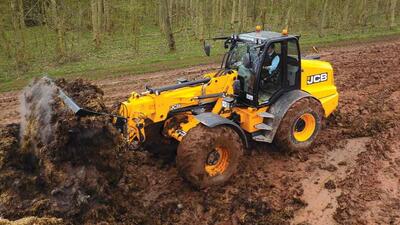
MACHINE CONSTRUCTION
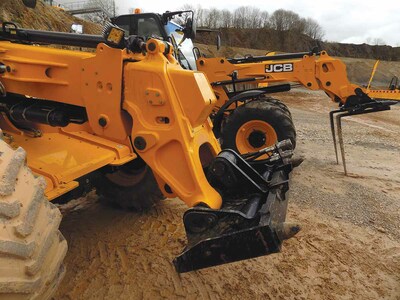
Much of the major updates can be found in the chassis and boom of the TM420, necessary to facilitate the extra lift.
In the middle of the machine a new steel casting now supports the centre pivot. This is said to eliminate potential weak spots which can be found with a multi-joint fabricated piece.
Similarly, a new inner boom comprises a cast steel construction to cope with greater loads.
Another big redesign comes at the boom end, which sees a new fork-shaped boom head introduced.
This features no cross member, which allows for a more optimum field of movement for the crowd/tilt connecting rod and ram. JCB says this puts a lot less stress on the machine and affords a tear out load of 7.2 tonnes depending on bucket, which certainly showed in the muck heap.
As for the headstock, even the traditional pin and cone tool carrier has been to the gym. As a result, it has been beefed up and now encases all the hydraulic locking mechanism, keeping it much more protected. However, this means a separate pallet tine attachment is now required.
As ever, JCB's Q Fit and Volvo-style industrial headstocks are available.
For extra reliability and reduced maintenance, every pin on the machine is larger and supported by self-lubricating bronze bushes featuring graphite nodules.
As introduced on 2016 TM320s, this allows for 500 hour greasing intervals, even on high intensity use machines, matching the service interval periods of the engine.
Up top, anyone used to a TM320 machine built after 2016 will be familiar with the cab on the TM420, which shares exactly the same structure, layout and controls.
This is a good thing too as it is an intuitive operating environment, even for non-JCB users - all the levers and buttons do what they say on the tin.
HYDRAULICS AND HANDLING

While the TM420's lift height gets a modest 250mm increase over the TM320, its payload is where it makes most gains, getting an extra 900kg.
In essence, the extra lift height will compensate for the use of larger buckets, maintain tilt angles above high sided trailers.
Although the TM420 gets the same 160l/min hydraulic pump as the TM320, the use of large bore hoses and pipes means there is less restriction on oil flow.
As a result, hydraulic performance is greatly improved, evident when carrying out short cycle work such as loading a muck spreader or grain trailer.
Aiding this performance is the use of regenerative hydraulics. This is essentially a clever ‘float' function for the boom, which uses gravity rather than powered hydraulics to lower the boom.
It is quick too, taking less than five seconds to go from maximum height to ground level. And whether carrying two tonnes or four tonnes, this time is maintained allowing for greater and more predictive control of the boom.
Swift
As well as boom raise/lower, boom in/out and third service actions are swift. However, generating a decent bucket shake action does require you to really work the ‘stick. This would be good if it was more responsive.
As for the third service, the flow of this can easily be dialled up or down via a dial in the cab.
For comfort, the lift, boom and tipping rams all feature a cushioning system. In addition, there are less hoses routed through the boom, for ease of maintenance.
Compared to the TM320, the 420 features a faster steering rack. This rewards fast inputs with a more aggressive steering action, and gentler inputs with more precise steering. This sees the number of turns lock to lock vary from about three to six.
ENGINE AND TRANSMISSION

Comprising a 4.8-litre, four-cylinder JCB Ecomax engine and six-speed powershift transmission with torque convertor, the TM420 sticks with the proven driveline of the TM320.
The rear features familiar engine bay territory too, sporting a wide core cooling pack with intercooler, transmission, hydraulics and water radiators all stacked on top of each other to make an easy to get to single wall.
A reverse fan is optional, which can simply be manually turned on or set to 15 or 30 minute intervals, via a rocker switch.
For more efficient road work, torque lock up is available in gears four to six. As mentioned, this won't make it the best clamp climber in the world, but it could do that first easy morning of silaging if needs be - we might find out if it ever dries up.
For yard work such as powering a bedding machine, where you want to control forward speed independently of engine rpm, a torque converter will always lose out to a hydrostatic.
However, JCB claims feedback suggests a torque converter is better when it comes to a wider variety of jobs.
Axles
Coping with the TM420's extra load are a pair of larger JCB axles, supplied as standard with limited slip differentials, as found on the firm's 10 tonne wheeled loaders. These are a beefier category compared to the axles found on the TM320 and feature twice as many studs - 10 for each hub.
For increased traction, larger 26 inch wheels can now be fitted. Depending on tyre choice, the width of the machine is still very similar to the TM320. This is the case on Michelin's 480/80 R26 BibLoad loader tyres and equivalent sized ag tyres.
Largest tyres which can be fitted are 620/70 R26, as fitted to our test machine helping navigate the less than ideal conditions.
TM420 SPECIFICATIONS
Engine: 4.8-litre, four-cylinder, JCB Ecomax
Power: 145hp
Transmission: six-speed torque convertor with lock-up in gears four to six
Lift capacity: 4,100kg
Lift height: 5,450mm
Bucket tearout capacity: 7,200kg
Length: 7,011mm
Width (on 480/80 R26 tyres): 2,350mm
Height: 2,827mm
Availability: Now with production starting in July
List price: £104,163
FG VERDICT
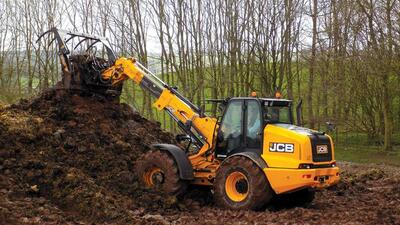
Not just a beefed up TM320 with a larger counterweight, the 420 is very much a new machine.
Despite its extra beef, its relative compact dimensions are impressive and should suit those traditional farm buildings still used.
Hydraulic performance, particularly its regenerative package, is the icing on the cake, avoiding the need for those brief pauses when all too often the boom has not lowered as quickly as you would like.
In all, it should satisfy customers which have outgrown the TM320 and want something with a bit more punch.
And although there is currently no ‘S' version of the 420, in these cost conscious times there is little doubt that customers will want to get the most out of their machine and use it do as many jobs as possible, including clamp work.
This would suggest an ‘S' version should be on JCB's cards, if it is not already, giving people the option as they have with the TM320 and TM320S.










